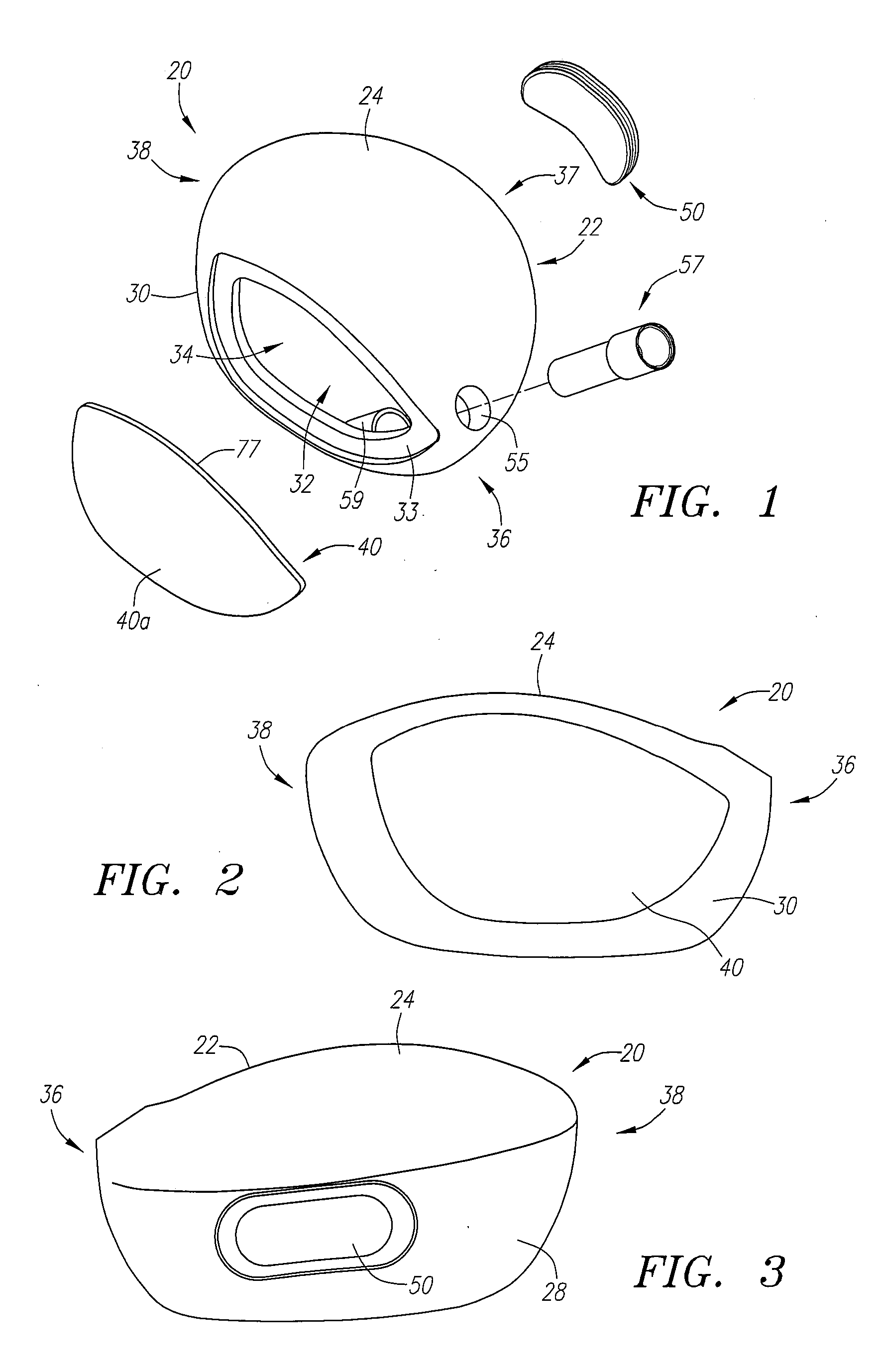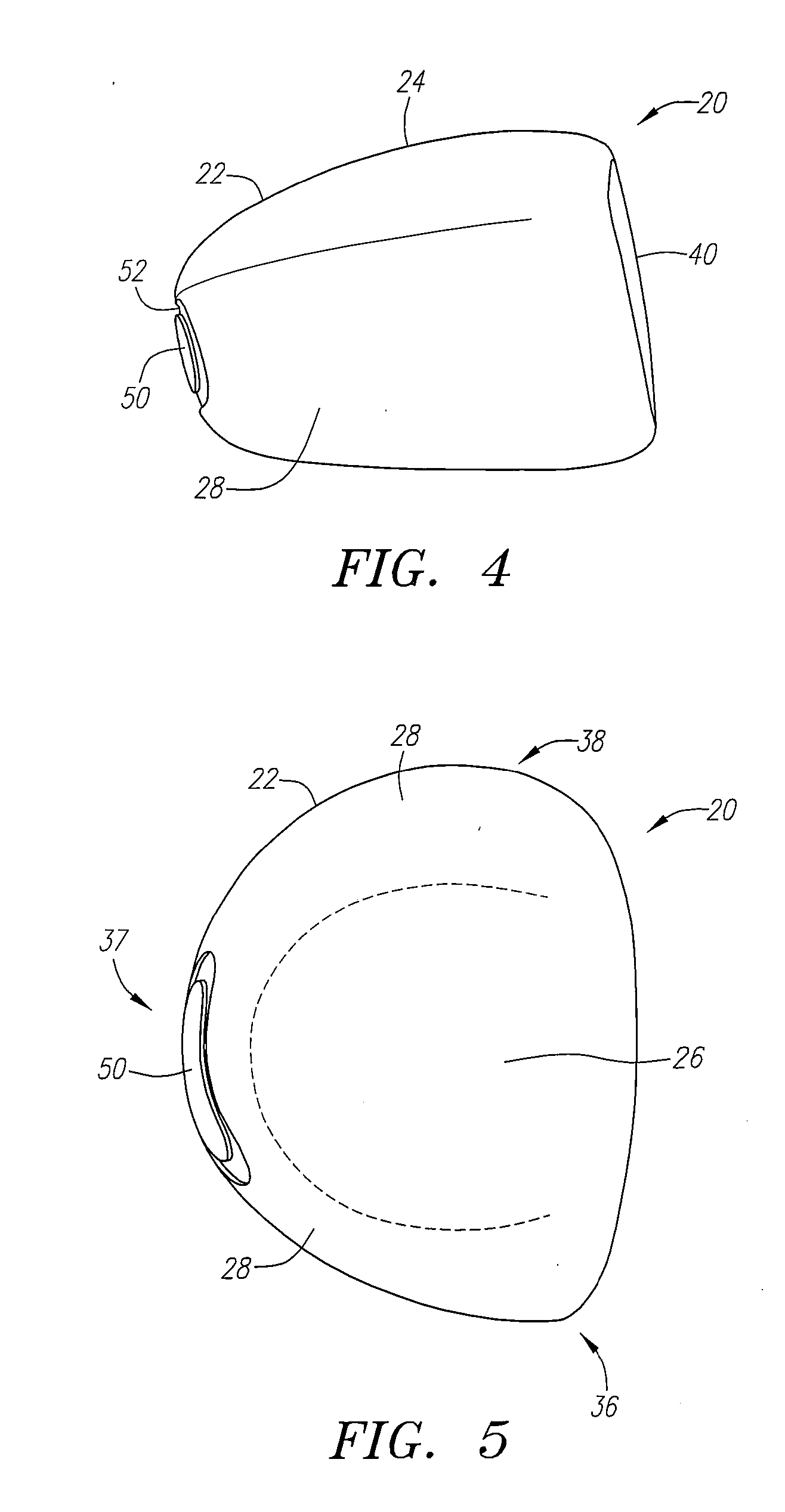Golf Club Head
a golf club and head technology, applied in the field of golf club head, can solve the problems of increasing dispersion, reducing distance, and reducing dispersion, and achieve the effect of improving mass distribution
- Summary
- Abstract
- Description
- Claims
- Application Information
AI Technical Summary
Benefits of technology
Problems solved by technology
Method used
Image
Examples
second embodiment
[0077] the golf club head 20 of the present invention is shown in FIG. 11. In this embodiment, the golf club head has a body 22 that is generally composed of a composite material such as continuous fiber pre-preg material (including thermosetting materials or thermoplastic material for the resin), other thermosetting materials such as thermosetting polyurethane, or other thermoplastic materials such as polyamides, polyimides, polycarbonates, PBT (polybutlene Terephthalate), blends of polycarbonate and the like. The body 22 is preferably manufactured through injection molding, bladder-molding, resin transfer molding, resin infusion, compression molding, or similar process.
[0078] The body 22 includes a front wall 30, a sole 26, and a ribbon 28 that generally extends from a toe end 38 to a heel end 36. The ribbon 28 generally begins at one end of the front wall 30 and ends at an opposite end of the front wall 30. A rear 70 of the body 22 is opposite the front wall 30 and is defined by ...
third embodiment
[0084] the golf club head 20 of the present invention is shown in FIG. 12. In this embodiment, the golf club head 20 has a face component 60 and an aft-body 61. The aft-body 61 has a crown portion 62 and a sole portion 64. The club head 20 has a heel section 66 proximate the shaft 48, a toe section 68 opposite the heel section 66, and a rear section 70 opposite the face component 60. A hosel 57, not shown, is positioned within the hollow interior 34 of the club head 20 in the face component 60.
[0085] The face component 60 is generally composed of a composite material, such as a continuous fiber pre-preg material or other thermosetting or thermoplastic material. The face component 60 includes a front wall 30 and return portion 63. Like the body 22 in the second embodiment of the golf club head 20, shown in FIG. 11, the face component 60 includes a weight piece 46 preferably embedded therein, the weight piece 46 includes a striking plate insert 40 and return portion tabs 46c. The weig...
fourth embodiment
[0089] the golf club head 20 of the present invention is shown in FIGS. 13-15, such as disclosed in U.S. Pat. No. 6,565,452, for a Multiple Material Golf Club Head with Face Insert, filed on Feb. 28, 2002, and is hereby incorporated by reference in its entirety. In this embodiment, the golf club head 20, a face component 60 and an aft-body 61. The face component 60 has a face cup and has a separate striking plate insert 40, which is placed within an opening 45 of a face cup 74. The aft-body 61 has a crown portion 62 and a sole portion 64.
[0090] The face cup 74 has a return portion 63 that extends laterally rearward from the perimeter 73 of the front wall. The striking plate insert 40 is joined to the face cup 74 of the face component 60 in a manufacturing process discussed in co-pending U.S. application Ser. No. 10 / 710,143, entitled Method for Processing a Golf Club Head with Cup Shaped Face Component, filed on Jun. 22, 2004, and hereby incorporated by reference in its entirety.
[00...
PUM
 Login to View More
Login to View More Abstract
Description
Claims
Application Information
 Login to View More
Login to View More - R&D
- Intellectual Property
- Life Sciences
- Materials
- Tech Scout
- Unparalleled Data Quality
- Higher Quality Content
- 60% Fewer Hallucinations
Browse by: Latest US Patents, China's latest patents, Technical Efficacy Thesaurus, Application Domain, Technology Topic, Popular Technical Reports.
© 2025 PatSnap. All rights reserved.Legal|Privacy policy|Modern Slavery Act Transparency Statement|Sitemap|About US| Contact US: help@patsnap.com



